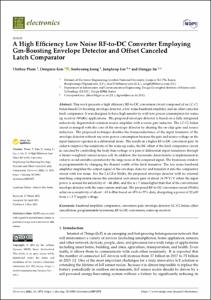Department of Electrical Engineering and Computer Science
Integrated Nano-Systems Laboratory
1. Journal Articles
A high efficiency low noise rf-to-dc converter employing gm-boosting envelope detector and offset canceled latch comparator
- Title
- A high efficiency low noise rf-to-dc converter employing gm-boosting envelope detector and offset canceled latch comparator
- Author(s)
- Pham, Thithuy ; Kim, Dongmin ; Jeong, Seohyeong ; Lee, Junghyup ; Im, Donggu
- DGIST Authors
- Pham, Thithuy ; Kim, Dongmin ; Jeong, Seohyeong ; Lee, Junghyup ; Im, Donggu
- Issued Date
- 2021-05
- Type
- Article
- Author Keywords
- Baseband amplifier ; Comparator ; Conversion gain ; Envelope detector ; LC-CL balun ; Offset cancellation ; Programmable hysteresis ; RF-to-DC conversion ; Wake-up receiver
- Keywords
- BENEFITS
- ISSN
- 2079-9292
- Abstract
- This work presents a high efficiency RF-to-DC conversion circuit composed of an LC-CL balun-based Gm-boosting envelope detector, a low noise baseband amplifier, and an offset canceled latch comparator. It was designed to have high sensitivity with low power consumption for wakeup receiver (WuRx) applications. The proposed envelope detector is based on a fully integrated inductively degenerated common-source amplifier with a series gate inductor. The LC-CL balun circuit is merged with the core of the envelope detector by sharing the on-chip gate and source inductors. The proposed technique doubles the transconductance of the input transistor of the envelope detector without any extra power consumption because the gate and source voltage on the input transistor operates in a differential mode. This results in a higher RF-to-DC conversion gain. In order to improve the sensitivity of the wake-up radio, the DC offset of the latch comparator circuit is canceled by controlling the body bias voltage of a pair of differential input transistors through a binary-weighted current source cell. In addition, the hysteresis characteristic is implemented in order to avoid unstable operation by the large noise at the compared signal. The hysteresis window is programmable by changing the channel width of the latch transistor. The low noise baseband amplifier amplifies the output signal of the envelope detector and transfers it into the comparator circuit with low noise. For the 2.4 GHz WuRx, the proposed envelope detector with no external matching components shows the simulated conversion gain of about 16.79 V/V when the input power is around the sensitivity of −60 dBm, and this is 1.7 times higher than that of the conventional envelope detector with the same current and load. The proposed RF-to-DC conversion circuit (WuRx) achieves a sensitivity of about −65.4 dBm based on 45% to 55% duty, dissipating a power of 22 µW from a 1.2 V supply voltage. © 2021 by the authors. Licensee MDPI, Basel, Switzerland.
- Publisher
- MDPI AG
- Related Researcher
-
-
Lee, Junghyup
- Research Interests Analog and Mixed Signal IC Design; Smart Sensor Systems; Bio-medical ICs and Body Channel Communication Systems
-
- Files in This Item:
-
 기타 데이터 / 4.06 MB / Adobe PDF
download
기타 데이터 / 4.06 MB / Adobe PDF
download



